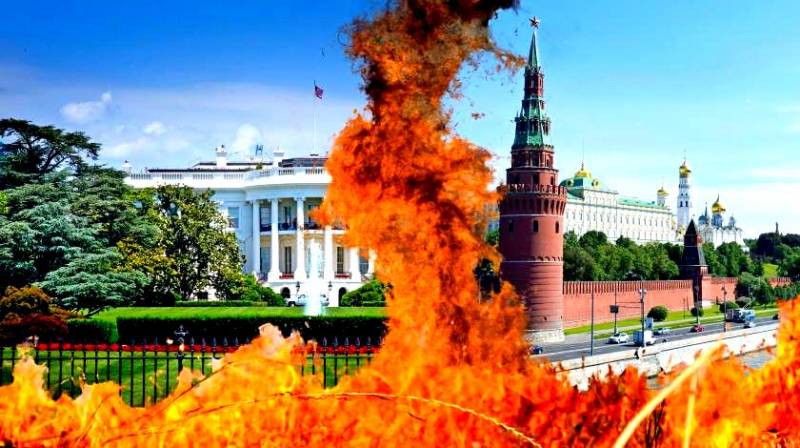This is just the beginning: what will be the next blow of the USA
The events of the last eight months (August 2017 - April 2018) allow us to make an unambiguous conclusion about the full design of the new Russian, - and more precisely, anti-Russian - policy Washington.
This policy can be described as an independent doctrine with the code name Virus Threat Strategy. Let's try to indicate in a first approximation the main features of this strategy:
The next move in the US strategy described above, apparently, is financing anti-Russian projects in the immediate vicinity of the borders of the Russian Federation, including the already announced USAID allocation of $ 65 million for the so-called “restoration of the Donbass”, as well as sponsoring the “bold young people” mentioned by the future US Secretary of State Mike Pompeo people ”in Ukraine and Georgia.
The main open question for the Kremlin in this situation is the search for appropriate responses to the implementation of the virus threat strategy in order to establish the optimal balance of wins and losses of the parties involved, and to realize the sovereign interests of Russia.
This policy can be described as an independent doctrine with the code name Virus Threat Strategy. Let's try to indicate in a first approximation the main features of this strategy:
- qualification of Russia at the level of US law as an “adversary of America” along with Iran and North Korea in accordance with CAATSA law
- identification of the Russian Federation as a rival power that undermines US interests around the world, and a revisionist state seeking to restore its great power status and establish spheres of influence close to its borders (according to the updated National Security Strategy - NSS-2017);
- recognition of a long-term strategic competition with Russia as a principal priority of the US Department of Defense, requiring an unreasonable increase in investment in relevant programs of the Ministry of Defense (according to the National Defense Strategy - NDS-2018);
- assessment of the practice of training the Russian armed forces and some provisions of the Russian nuclear doctrine as a desire to lower the "nuclear threshold" and readiness for limited use of low-power nuclear weapons first, taking into account the absence of an appropriate response from the United States and its allies (according to the NPR Review - NPR -2018);
- the formation of the mechanism of anti-Russian sanctions, as sequentially and independently unfolding actions, which are actually self-extracting as a virus computer program (according to the CAATSA law, local sanctions initiatives in connection with the British Skripal case, accusations against the Syrian government of using chemical weapons);
- inflicting information and reputation attacks on Russia from “virtual reality”, the correspondence of which to real events and facts is very conditional, or is not required at all (Skripal’s case and circumstances of a missile strike on Syria, built on conjectures, direct accusations and without any serious verification of facts );
- the desire to cause material and economic damage to Russia from areas in which a direct response is unlikely or difficult (the general logic of the deployment of anti-Russian sanctions);
- the simultaneous unfolding of several anti-Russian actions on a wide front with an explosive increase in intensity and a gradual decline, initiating subsequent actions (March-April 2018 events);
- the formation of conflicting and aggressive information flows that give the impression of a mental imbalance of the top leadership of the United States and its allies, with a shift to zones of irrationality, emotional and psychological pressure, largely identical to the informational techniques of the masters of psychological warfare Adolf Hitler and Joseph Goebbels (informational aspects of the Skripal case and the Syrian missile crisis);
- the desire for a dosed, controlled and, if possible, unexpected use of military force (development of the Syrian missile crisis);
- the interpretation of each own hostile act against Russia and its allies as a kind of “signal”, which is produced with the aim of obtaining an outwardly formalized and undescribed result from the opposing side, in the case of ignoring the “signal”, it is repeated more intensely and harshly (see. comments by US officials on anti-Russian sanctions and the Syrian missile crisis).
The next move in the US strategy described above, apparently, is financing anti-Russian projects in the immediate vicinity of the borders of the Russian Federation, including the already announced USAID allocation of $ 65 million for the so-called “restoration of the Donbass”, as well as sponsoring the “bold young people” mentioned by the future US Secretary of State Mike Pompeo people ”in Ukraine and Georgia.
The main open question for the Kremlin in this situation is the search for appropriate responses to the implementation of the virus threat strategy in order to establish the optimal balance of wins and losses of the parties involved, and to realize the sovereign interests of Russia.

Information